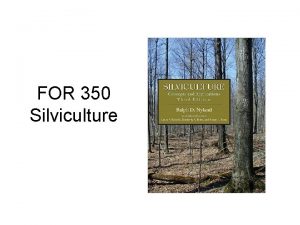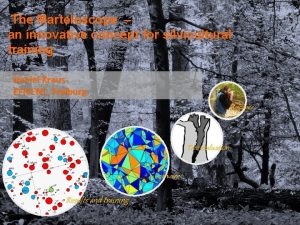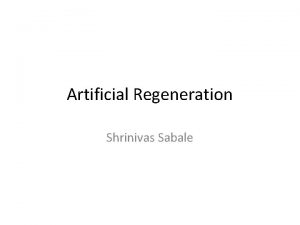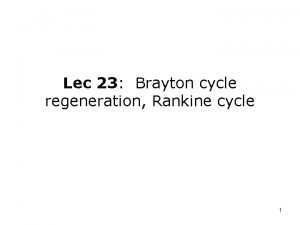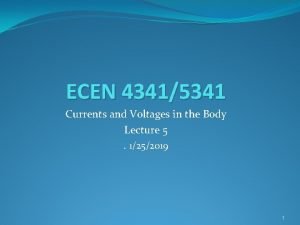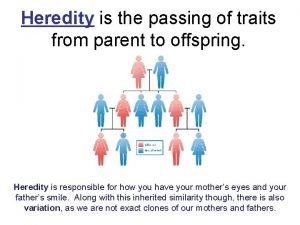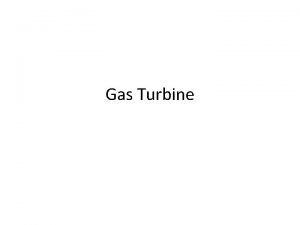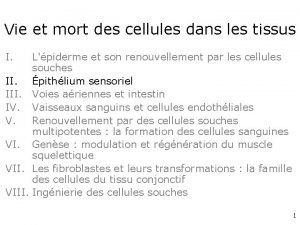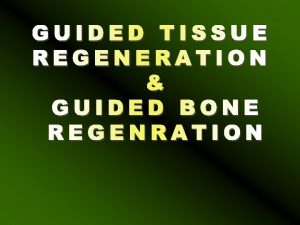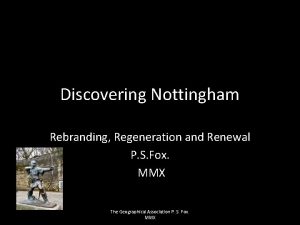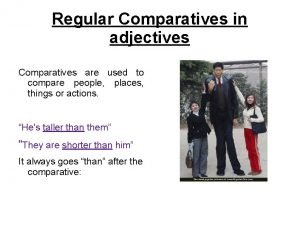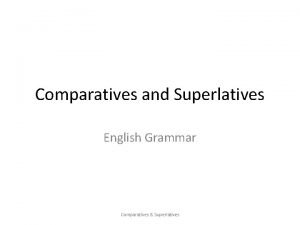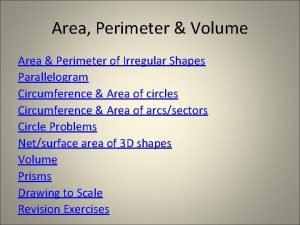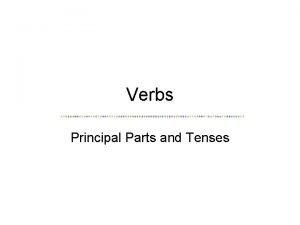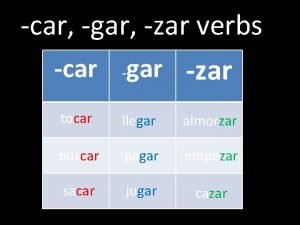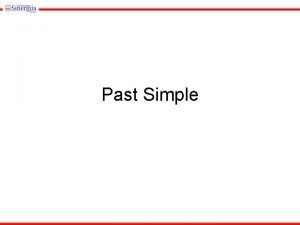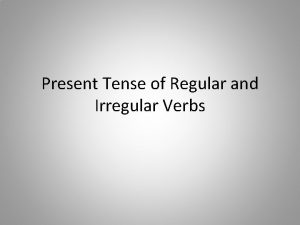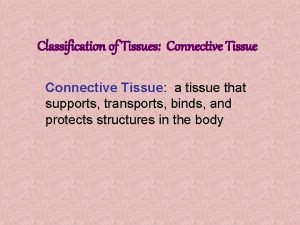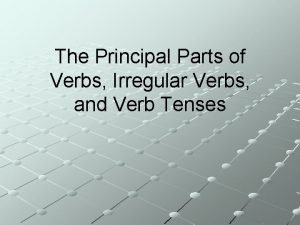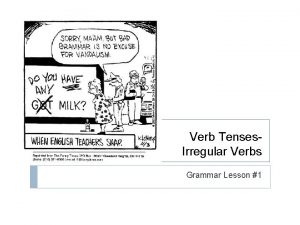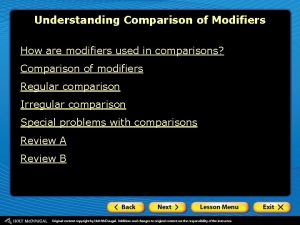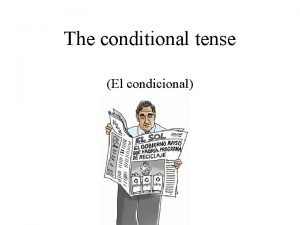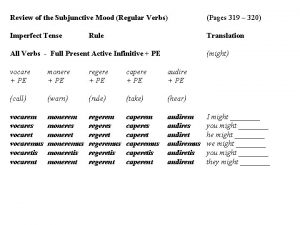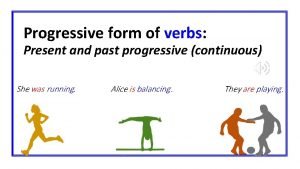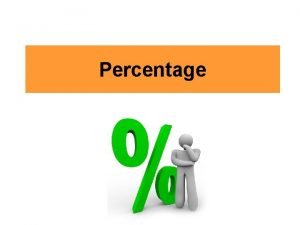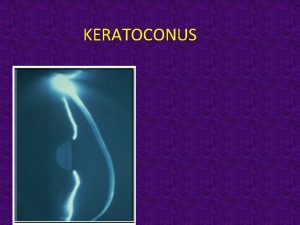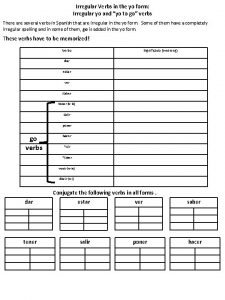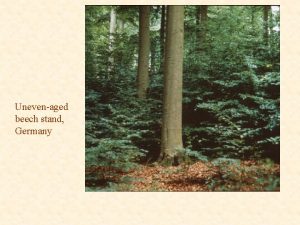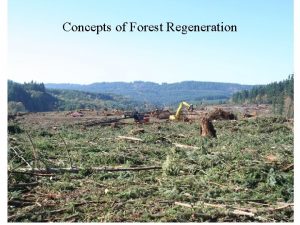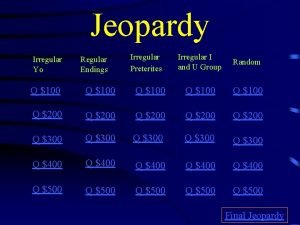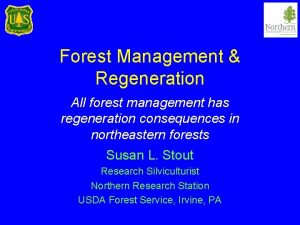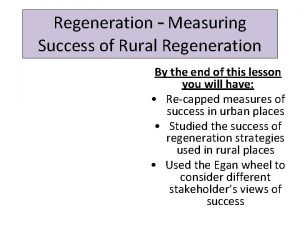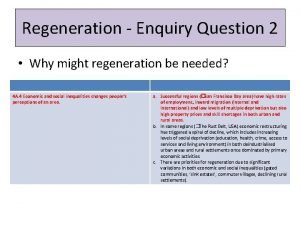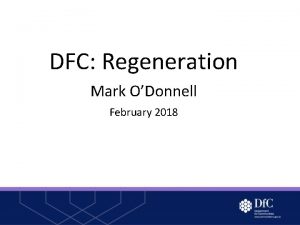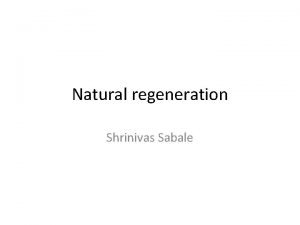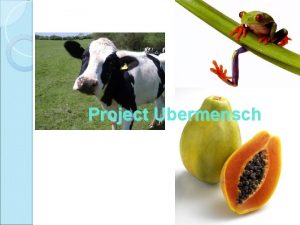Multiaged Systems Unevenaged and Irregular Silviculture Unevenaged Regeneration







































































- Slides: 71

Multiaged Systems Uneven-aged and Irregular Silviculture

Uneven-aged Regeneration Systems • Uneven-aged regeneration systems often referred to as selection systems – Not equivalent to "selective" cutting – “Selective" logging and "select-cut" merely means harvest is not a clearcut • Terms are imprecise as they could refer to systematic silvicultural methods or exploitive high-grading

Characteristics of Uneven-aged Systems • Selection methods produce an uneven-aged stand (with at least 3 age classes or distinct cohorts)

Characteristics of Uneven-aged Systems • Maintains continuous high forest cover • Typically emphasizes sawtimber production • Regulation methods allow sustained yield at recurring intervals – If balanced, each harvest removes amount equivalent to growth produced since the last harvest • Useful for putting an irregular stand under productive management without losing existing stocking

Characteristics of Uneven-aged Systems • Rotation length is the average time period required to obtain trees of target size • The period between harvests (in years) is the length of the cutting cycle – Harvests occur regularly at short intervals throughout the rotation – Cutting cycle is normally between 5 to 20 years

Characteristics of Uneven-aged Systems • Intermediate treatments should be completed to ensure continued recruitment and favorable growth among residual trees • For sustained yield, systems requires frequent and accurate inventory

Potential Objectives/Benefits in Using a Selection System • Maintains structural diversity within stand • Maintains good site protection – although frequent logging may result in increased soil damage on sensitive sites • Pleasing aesthetics without time gaps • Frequent periodic income • Good flexibility – • Maintains a reserve of large trees on the stump (thus one can take advantage of market fluctuations) Requires only a low investment in regeneration

Potential Drawbacks/Disadvantages of Selection Systems • Involves a high level of complexity, requires higher management costs than other methods • Produces less pulpwood than other methods • Harvesting more difficult and costly per unit area than with even-aged methods • Results in more logging damage to residual trees than with even-aged methods – • Due to frequent entry of harvesting equipment Leads to long-term depletion of growing stock if not applied carefully

Characteristics of Uneven-aged Systems • Uneven-aged regeneration methods provide openings for establishment and recruitment of new age classes (cohorts) • Selection methods are traditionally classified as either – – • Single-tree selection Group selection In practice, selection methods can create a continuum from very small to large regeneration openings

Variations of the Selection Method Single Tree Selection: removes individual trees of all size classes more or less uniformly throughout the stand to maintain an uneven-aged stand achieve other stand structural objectives


Variations of the Selection Method Single Tree Selection • More commonly applied in: – Shade tolerant species • Norway spruce, beech, silver fir (central Europe) • Sugar maple, American beech, birch (Northern hardwoods) – Restrictive sites where pronounced seasonal water limitations favor natural monocultures • Ponderosa pine • Has been used for other forest types – Upland oak forests of the Missouri Ozarks (Pioneer Forest, MO) – Loblolly-shortleaf pine (Crossett Experimental Forest, AR) – Longleaf pine, southern Coastal Plain region

Variations of the Selection Method Single Tree Selection • Central and southern upland bottomland hardwoods – Generally, without intensive competitor control, single tree selection has resulted in a transition to shade tolerant species

Variations of the Selection Method • Group Selection: removes clusters of adjacent trees from a predetermined proportion of the stand area – Group selection was developed to create larger openings needed to regenerate shade-intolerant and intermediate species

Application of group selection • Openings must be wide enough to allow good regeneration establishment – Due to shading effects of edge, best success and growth of intolerant seedlings may be restricted to 2/3 or less of the area in a small opening – In the Central Hardwood Forest Region, opening sizes are typically between 1 and 2 times the height of surrounding trees • Locate harvest groups among the oldest or largest trees in the stand • Appropriate tool for other objectives—wildlife openings, aesthetics, salvage/sanitation

Application of group selection • Opening shape to fit the stand conditions or to maximize objectives/constraints – Rectangular openings will be more efficient for logging than circular – Rectangular openings provide more sun if oriented with their long axes east-west • Group selection is easier to plan and keep the stand balanced than with single-tree • Logging is more efficient and less damaging to residual trees than with single-tree

Application of group selection • Complete felling of all trees in the openings is crucial to allow for good regeneration • Control of undesirable species should be considered – • Possibly pre- or post-harvest injection, basal bark herbicides, or cutting Tend the remaining uncut stand areas between group openings

Issues associated with group selection • Group selection is often confused with patch clearcutting • If groups are managed as an individual “stand” and tracked through time as such, you are using even-aged silviculture at a small spatial scale • Openings in group selection should not exceed 2 times the height of adjacent mature trees • Difficult (or impossible) to locate groups within a stand following second or third entry

Regulating Selection Systems

Approaches to regulation in the selection method and maintaining a balanced stand with sustainable yield 1. Area regulation 2. Volume regulation 3. Structural regulation

Area regulation: this is the simplest, and is fairly easy with a group selection system, but it is difficult with the single-tree approach. – Combined area of all trees removed in each cutting cycle:

Volume regulation: harvest the allowable cut each cutting cycle -- if a stand is balanced, this is equal to the growth during the cutting cycle period

• Structural regulation: use a reverse J-shaped curve of residual diameter distribution as a guide.

Balance vs. Irregular (unbalanced) uneven-aged stands

Structural regulation and Guiding Curve • In balanced uneven-aged stands with an reverse-J shape distribution, a constant ratio exists between the number of trees in successive diameter classes. • This relationship defines the shape (steepness or flatness) of the structural regulation guiding curve and is called the q factor (or quotient) q= where, Ni = number of trees in the ith diameter class Ni+1 = number of trees in next largest diameter class

Influence of q on Target Diameter Distribution • A smaller q value more large trees and fewer smaller trees • A larger q leaves fewer large trees, more smaller tree (i. e. less sawtimber)

Silvicultural Approaches to Creating Irregular Stand Structures

Creating Irregular Stand Structures • Irregular silviculture seeks to create stands with: – Continuous canopy cover – Variation in age structure and spatial arrangement – Multilayered canopies with tree crowns at various height levels (stratum) – Practices increase or create heterogeneity within stands and allow complexity to develop through time • While uneven-aged selection systems create irregular stands, all irregular silvicultural practices do not necessarily seek to: – Balance the age classes – Maintain stable diameter distributions – Realize consistent yield at regular intervals (cutting cycles) through time

Creating Irregular Stand Structures • Irregular silviculture differs from selective cutting (an exploitive strategy) by: – Tending and regenerating economically and ecologically important species and sustaining values and interests through time – Practices do not compromise future production or ecological function • While irregular silviculture does not have to closely regulate spatial or temporal arrangements of age classes, it must: – Plan for deliberate regeneration of replacement trees to maintain the irregular age class and structural attributes – Invest in tending to nurture the recruitment and growth of target trees at different stages of development – Make treatments financially feasible and provide a revenue stream to pay ownership and management costs

Creating Irregular Stand Structures • First step in developing irregular stand structures is to create a two-aged stand • Irregular silviculture practices are referred to as: – – – Continuous cover forestry Femelschlag Dauerwald Close to nature forestry (Pro Silva Europe) Ecological forestry Variable retention harvesting – Methods utilized in irregular silviculture include: selection systems (group and single-tree), irregular and group shelterwoods, variable density-thinning, “free” selection

Creating Irregular Stand Structures

Creating Irregular Stand Structures

Creating Irregular Stand Structures

Two-Aged Silviculture

Two-Aged Silviculture • Two-aged management is a hybrid between even-aged management and uneven-aged management • Regeneration is accomplished (in general) two times over a standard rotation. – Two age classes

Benefits of a Two-Aged System • Increased structural diversity and retention of habitat components compared to even-aged methods • Production of a wide range of forest products from pulp to large-diameter sawtimber in the same stand at the same time • Ability to regenerate shade-intolerant and intermediate shadetolerant species • Improved aesthetics compared to clearcutting


Benefits of a Two-Aged System • Increased initial revenue compared to other types of nonclearcut regeneration techniques • Development of old-growth structural characteristics • Maintenance of seed production in reserve trees throughout the entire rotation • Ability to “life boat” species that would otherwise be eliminated if the area was clearcut

Constraints/Undesirable Features of Two-Aged System • Reducing older age classes to low densities and wide spacing increase the danger of blowdown • Residual trees may be prone to epicormic branching – Reserve trees must be carefully selected • Lack of appropriate long-lived species to maintain the system

Reserve Tree Criteria • Long-lived commercial species • Appropriate crown characteristics including live crown ratios (typically > 40 for hardwoods), well-balanced crown proportions and overall crown vigor • Stem form and maintenance of potential veneer or high-quality sawtimber • Ability to withstand harvest • Located to avoid wind-throw and other post-harvest perturbations


Constraints/Undesirable Features of Two-Aged System • Forest fragmentation and habitat effects similar to clearcutting • Reduction in initial revenues compared to clearcutting • Limited development of shade-tolerant species • Damage to new age-class trees if a portion of reserve trees are removed prior to the end of the second rotation length

Two-aged Regeneration Methods • Two-aged stands can be created in a single treatment or through multiple entries – Single entry: deferment or leave-tree methods – Multiple entry: Reserve shelterwood • Basal area of reserve trees (i. e. , the oldest age class) does not typically exceed 25 ft 2 ac-1

Deferment or Leave-Tree Approach Uncut Stand Reserve trees (1015 ft 2 ac-1 BA)

Deferment or Leave-Tree Approach

Reserve Shelterwood Uncut Stand Establishment Cut* (45 -60 ft 2 ac-1 BA) Reserve trees (1015 ft 2 ac-1 BA) *Similar to the uniform shelterwood (even-aged), an optional preparatory cut may proceed the establishment cut

Variable Retention Harvesting

Variable Retention Harvesting • Variable retention harvesting aims to retain legacies from the past and enrich the new community with structural features reminiscent of older forests • With regeneration units of older stands, – Retain large and decedent trees, maintain course woody debris, and reduce disturbances to forest floor – Retained attributes as dispersed elements or aggregated in small patches of residual forest – Results in an irregular forest of at least two ages

Variable Retention Harvesting • In intermediate aged stands – Intermix thinned patches with variable levels of residual stocking • Stimulates residual tree development, creates horizontal heterogeneity in stand conditions and structure, and establishes gaps of various sizes to establish and release regeneration • Attempts to mimic disturbances considered natural for the region

Variable Retention Harvesting Dispersed Retention

Variable Retention Harvesting Aggregated Retention

Irregular Shelterwood Systems • Three general classifications: – Expanding-gap irregular shelterwood – Continuous cover irregular shelterwood – Extended irregular shelterwood

Irregular Shelterwood Systems Expanding-gap irregular shelterwood “Aims to regenerate new cohorts in groups that are gradually enlarged until the stand is totally removed”

Expanding-gap irregular shelterwood

Expanding-gap irregular shelterwood Initial Gaps

Expanding-gap irregular shelterwood Preparatory/establishment cutting around gaps

Expanding-gap irregular shelterwood Preparatory/establishment cutting following gap expansions

Expanding-gap irregular shelterwood Final removal of areas receiving preparatory/establishment cutting

Expanding-gap Irregular Shelterwood

Irregular Shelterwood Systems Continuous cover irregular shelterwood – “Sequence of cuttings is applied more freely in space and time, which permits maintenance of a multicohort structure and a continuous forest cover ”

Continuous cover irregular shelterwood

Irregular Shelterwood Systems Extended Irregular Shelterwood – “Aims to regenerate the whole stand while … two cohorts are maintained for at least 20% of the rotation length”

Extended irregular shelterwood

Other Partial Cutting

Other Partial Cuttings • Timber harvesting vs. Silviculture – Timber harvesting extracts a product – Silviculture involves a determined effort to regenerate mature trees or tend immature ones and to provide by the future by using harvesting to recover products that become a byproduct of systematic management

Other Partial Cuttings (non-silvicultural treatments) • Non-silviculture, exploitative partial (selective) cutting treatments – Commercial clearcutting: removal of only commercially salable trees – High-grading: removal of choice species or trees larger than a specified diameter limit if they fit common utilization standards – Diameter-limit cuttings: removal of all trees larger than a specified diameter

Disadvantages of Non-Silviculture Partial Cuttings • Does not move forests toward a controlled age or size class distribution that ensures long-term sustained yields at predicable levels or intervals • Does not ensure adequate regeneration in terms of number, species, or distribution – In the Central Hardwood Region, repeated exploitative cutting yield a degraded stand composed primary of low-value, shade-tolerant species • Ignores silvical requirements of desired species with respect to regeneration and long-term growth • Removes acceptable growing stock and leaves defective and unhealthy trees

Rehabilitating Cutover Stands • Stand assessment initial step in rehabilitating cutover stands • Assessment determines: – – – • Abundance and distribution of suitable residual trees and their potential Status of advance reproduction Patterns of interfering understory vegetation Characteristics of suitable residuals – – – At least lower codominant > 20 to 25% live crown No (to few) epicormic branches on lower bole No apparent decay or damage of the main stem < 25% of major branches dead or dying < 10% lean

Rehabilitating Cutover Stands • High degree of stocking variability and patchiness makes stand-wide treatments impractical in many cases and prescription may use combination of methods within a stand

Silvicultural Methods for Rehabilitation • Complete tree removal as regeneration method for places lacking acceptable growing stock • Liberation cutting to release a younger age class already in place • Leaving widely space trees as shelterwood establishment cut or initiate a two-aged arrangement

Silvicultural Methods for Rehabilitation (cont. ) • Thinning even-aged patches with acceptable growing stock • Releasing widely spaced crop trees within main canopy without additional tending between (i. e. , crop-tree release) • Low-density selection systems for cutover uneven-aged areas
 Tending operations in forestry
Tending operations in forestry Silviculture objectives
Silviculture objectives Marteloscope definition
Marteloscope definition Gas turbine with regeneration
Gas turbine with regeneration London docklands regeneration
London docklands regeneration Objectives of artificial regeneration
Objectives of artificial regeneration T-s diagram brayton cycle
T-s diagram brayton cycle Fiat doblo dpf regeneration procedure
Fiat doblo dpf regeneration procedure Planarian regeneration
Planarian regeneration Organisms that reproduce asexually
Organisms that reproduce asexually Gas turbine classification
Gas turbine classification Cellules ciliées régénération
Cellules ciliées régénération Gbr in periodontics
Gbr in periodontics Nottingham redevelopment
Nottingham redevelopment Decision support systems and intelligent systems
Decision support systems and intelligent systems Principles of complex systems for systems engineering
Principles of complex systems for systems engineering Embedded systems vs cyber physical systems
Embedded systems vs cyber physical systems Engineering elegant systems: theory of systems engineering
Engineering elegant systems: theory of systems engineering Elliptical spiral and irregular
Elliptical spiral and irregular Comparative of regular
Comparative of regular Irregular preterites: venir, poner, decir, and traer
Irregular preterites: venir, poner, decir, and traer Excessive frequent and irregular menstruation artinya
Excessive frequent and irregular menstruation artinya Irregular adverb
Irregular adverb Irregular comparative and superlative
Irregular comparative and superlative Well in comparative
Well in comparative Adjectives irregular
Adjectives irregular Superlatives list
Superlatives list Irregular shapes area and perimeter
Irregular shapes area and perimeter Irregular solids
Irregular solids Principal parts of regular and irregular verbs
Principal parts of regular and irregular verbs Rosalinda invito a varios amigos
Rosalinda invito a varios amigos Tener preterite vs imperfect
Tener preterite vs imperfect Statue verbs
Statue verbs Do car gar zar verbs change in present tense
Do car gar zar verbs change in present tense Past simple irregular verbs meet
Past simple irregular verbs meet Thrust past tense and past participle
Thrust past tense and past participle Irregular adverbs comparative and superlative
Irregular adverbs comparative and superlative Jkolasin
Jkolasin Regular and irregular verbs play
Regular and irregular verbs play Fat connective tissue function
Fat connective tissue function Irregular verbs singular and plural
Irregular verbs singular and plural Principal parts of regular and irregular verbs
Principal parts of regular and irregular verbs Regular and irregular languages
Regular and irregular languages Irregular verbs venir
Irregular verbs venir Past tense choose
Past tense choose Clearly comparative and superlative
Clearly comparative and superlative 12500x4
12500x4 Definition of irregular galaxy
Definition of irregular galaxy Preterite sentences in english
Preterite sentences in english An abundance of coal an irregular coastline
An abundance of coal an irregular coastline The imperfect show
The imperfect show Yo tu ella chart
Yo tu ella chart Subjunctive irregular
Subjunctive irregular Realidades 2 irregular affirmative tu commands
Realidades 2 irregular affirmative tu commands Capitulo 3a irregular preterite verbs
Capitulo 3a irregular preterite verbs Past progressive with when and while
Past progressive with when and while Processos regulares de formação de palavras exercícios
Processos regulares de formação de palavras exercícios Organizar preterite
Organizar preterite Jugar subjunctive
Jugar subjunctive Past perfect of set
Past perfect of set Triangulo es regular o irregular
Triangulo es regular o irregular 4 sided shapes
4 sided shapes Cuerpos geometricos irregulares
Cuerpos geometricos irregulares Irregular adjective of elegant
Irregular adjective of elegant Oil droplet reflex keratoconus
Oil droplet reflex keratoconus Jeopardy irregular verbs
Jeopardy irregular verbs Irregular verbs pictures
Irregular verbs pictures Irregular yo form
Irregular yo form Rap verbs
Rap verbs Blow past simple
Blow past simple Past participlebuy
Past participlebuy Salgo infinitivo
Salgo infinitivo

